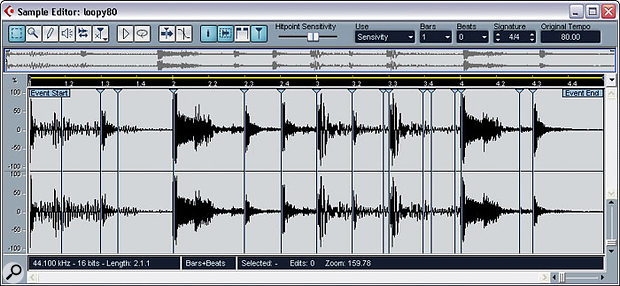 The Hitpoints mode in Cubase SX is designed to detect and mark individual hits, making beat-slicing easier.
The Hitpoints mode in Cubase SX is designed to detect and mark individual hits, making beat-slicing easier.
Cubase SX has a Detect Silence feature and a Hitpoints feature that seem to me like they do pretty much the same thing. Are they different, and when should I use them?
Ben Flanagan
SOS Contributor Len Sasso replies: Yes, those features are really quite different. Silence-detection software, of which SX's Detect Silence is an example, works by searching for areas in an audio file where the level drops below a given threshold for a specified minimum amount of time. Beat-slicing software, of which Hitpoints is an example, works by searching for abrupt changes in an audio file, presumably signalling individual events such as drum hits in a percussion file.
As the names imply, one of the main differences between Detect Silence and Hitpoints is that Detect Silence marks and optionally removes whole sections that it interprets as 'silence' (threshold, duration and other criteria are typically user-definable), while Hitpoints marks individual points in the audio file, the theory being that the region between two points represents a single event.
In a simple audio file, say a kick-drum part, Detect Silence could be used to separate the individual kicks, but in a busy percussion part, it's unlikely that individual events are separated by silence. Detect Silence would be no help in that case. On the other hand, Hitpoints would be little help picking out regions separated by silence in an audio file (such as a track from an audio sampling CD) because each region would most likely contain a large number of hitpoint markers, but none at the boundaries of the silent portions. In short, use Hitpoints for slicing up audio files into individual events and use Detect Silence for identifying (and possibly removing) low-level regions in an audio file.
No comments:
Post a Comment